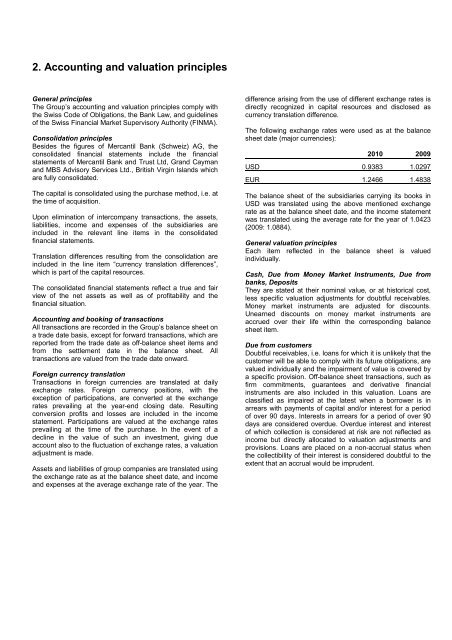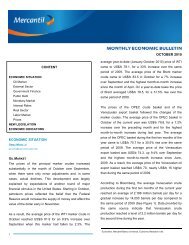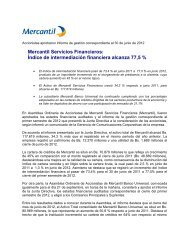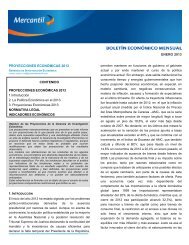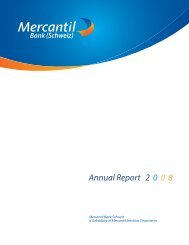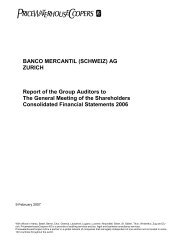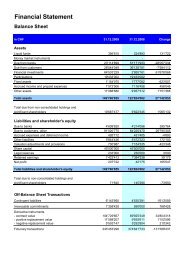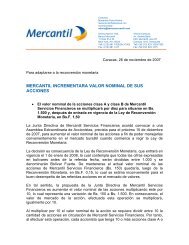Financial Statement - Banco Mercantil
Financial Statement - Banco Mercantil
Financial Statement - Banco Mercantil
You also want an ePaper? Increase the reach of your titles
YUMPU automatically turns print PDFs into web optimized ePapers that Google loves.
2. Accounting and valuation principles<br />
General principles<br />
The Group’s accounting and valuation principles comply with<br />
the Swiss Code of Obligations, the Bank Law, and guidelines<br />
of the Swiss <strong>Financial</strong> Market Supervisory Authority (FINMA).<br />
Consolidation principles<br />
Besides the figures of <strong>Mercantil</strong> Bank (Schweiz) AG, the<br />
consolidated financial statements include the financial<br />
statements of <strong>Mercantil</strong> Bank and Trust Ltd, Grand Cayman<br />
and MBS Advisory Services Ltd., British Virgin Islands which<br />
are fully consolidated.<br />
The capital is consolidated using the purchase method, i.e. at<br />
the time of acquisition.<br />
Upon elimination of intercompany transactions, the assets,<br />
liabilities, income and expenses of the subsidiaries are<br />
included in the relevant line items in the consolidated<br />
financial statements.<br />
Translation differences resulting from the consolidation are<br />
included in the line item “currency translation differences”,<br />
which is part of the capital resources.<br />
The consolidated financial statements reflect a true and fair<br />
view of the net assets as well as of profitability and the<br />
financial situation.<br />
Accounting and booking of transactions<br />
All transactions are recorded in the Group’s balance sheet on<br />
a trade date basis, except for forward transactions, which are<br />
reported from the trade date as off-balance sheet items and<br />
from the settlement date in the balance sheet. All<br />
transactions are valued from the trade date onward.<br />
Foreign currency translation<br />
Transactions in foreign currencies are translated at daily<br />
exchange rates. Foreign currency positions, with the<br />
exception of participations, are converted at the exchange<br />
rates prevailing at the year-end closing date. Resulting<br />
conversion profits and losses are included in the income<br />
statement. Participations are valued at the exchange rates<br />
prevailing at the time of the purchase. In the event of a<br />
decline in the value of such an investment, giving due<br />
account also to the fluctuation of exchange rates, a valuation<br />
adjustment is made.<br />
Assets and liabilities of group companies are translated using<br />
the exchange rate as at the balance sheet date, and income<br />
and expenses at the average exchange rate of the year. The<br />
difference arising from the use of different exchange rates is<br />
directly recognized in capital resources and disclosed as<br />
currency translation difference.<br />
The following exchange rates were used as at the balance<br />
sheet date (major currencies):<br />
2010 2009<br />
USD 0.9383 1.0297<br />
EUR 1.2466 1.4838<br />
The balance sheet of the subsidiaries carrying its books in<br />
USD was translated using the above mentioned exchange<br />
rate as at the balance sheet date, and the income statement<br />
was translated using the average rate for the year of 1.0423<br />
(2009: 1.0884).<br />
General valuation principles<br />
Each item reflected in the balance sheet is valued<br />
individually.<br />
Cash, Due from Money Market Instruments, Due from<br />
banks, Deposits<br />
They are stated at their nominal value, or at historical cost,<br />
less specific valuation adjustments for doubtful receivables.<br />
Money market instruments are adjusted for discounts.<br />
Unearned discounts on money market instruments are<br />
accrued over their life within the corresponding balance<br />
sheet item.<br />
Due from customers<br />
Doubtful receivables, i.e. loans for which it is unlikely that the<br />
customer will be able to comply with its future obligations, are<br />
valued individually and the impairment of value is covered by<br />
a specific provision. Off-balance sheet transactions, such as<br />
firm commitments, guarantees and derivative financial<br />
instruments are also included in this valuation. Loans are<br />
classified as impaired at the latest when a borrower is in<br />
arrears with payments of capital and/or interest for a period<br />
of over 90 days. Interests in arrears for a period of over 90<br />
days are considered overdue. Overdue interest and interest<br />
of which collection is considered at risk are not reflected as<br />
income but directly allocated to valuation adjustments and<br />
provisions. Loans are placed on a non-accrual status when<br />
the collectibility of their interest is considered doubtful to the<br />
extent that an accrual would be imprudent.


